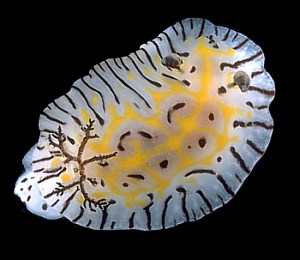
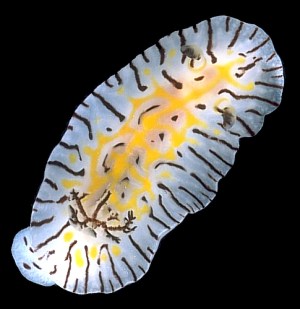
Halgerda elegans
Bergh, 1905
Order: NUDIBRANCHIA
Suborder: DORIDINA
Superfamily: EUDORIDOIDEA
Family: Dorididae
PHOTO
Solitary Ids., Coffs Harbour region, New South Wales, Australia, April 1987. 19mm long. PHOTOS: Bill Rudman.
Characterised by the radiating black lines forming a border around the mantle skirt. There is a reticulate pattern of yellow-edged ridges, and sometimes small black marks in the intervening spaces. One difference from Halgerda willeyi are the colour of the rhinophore clubs, which in that species are white with a black band around the mid-region, and in H. elegans are white with a longitudinal black band covering the posterior side of the club.
See Bergh's original illustrations of H. elegans.
See similarly coloured Halgerda graphica.
Reference:
• Gosliner, T.M. & Fahey, S.J. (1998) Description of a new species of Halgerda, with a redescription of Halgerda elegans Bergh, 1905. Proceedings of the California Academy of Sciences, 50(15): 346-359.
Rudman, W.B., 2000 (March 3) Halgerda elegans Bergh, 1905. [In] Sea Slug Forum. Australian Museum, Sydney. Available from http://www.seaslugforum.net/find/halgeleg
Related messages
Halgerda elegans from the Philippines?
April 9, 2007
From: Colin Teo
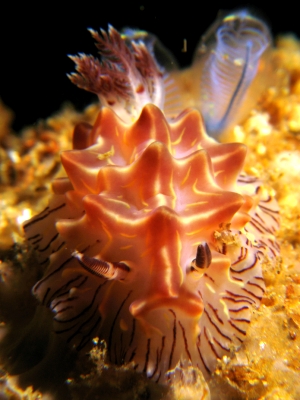
Hi,
Can you help to identify this species? I wonder if this is the Halgerda willeyi or the Halgerda elegans.
Locality: Malapascua, 13m, Philippines, 21 February 2007. Length: 4 cm. Photographer: Colin Teo.
Colin Teo
colin_teo@yahoo.com
Teo, Colin, 2007 (Apr 9) Halgerda elegans from the Philippines?. [Message in] Sea Slug Forum. Australian Museum, Sydney. Available from http://www.seaslugforum.net/find/19692Dear Colin,
Your animal looks very similar to Julie Marshall's photo [#2077] which we have identified as Halgerda elegans. There are two species of Halgerda with this radiating fringe of black lines around the mantle edge. In H. elegans the lines on the innner part of the mantle are yellow and the background translucent white, while in the other, H. albocristata, the background is yellowish and the lines are white.
However I still suspect there is some sorting out still to be done in this group. For example two messages [#2688, #8147] have photos of animals I have tentatively identified as H. willeyi, but are probably the same as your animal.
Sorry I can't be more definite
Best wishes,
Bill Rudman
Juvenile Halgerda sp. from Taiwan
July 5, 2002
From: Todd Garthwaite
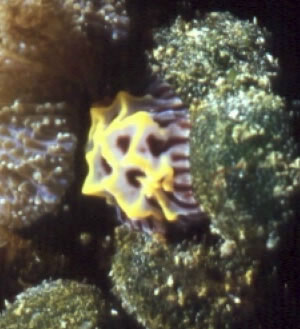
Hi Bill,
Here's a juvenile Halgerda sp., (H. elegans perhaps?), which I came across in an area strewn with rocks, rubble, silt, sand, very small patches of soft and hard coral, and these strange, green ping-pong ball shaped sponges (?) which are quite common near the mouth of Dragon Cave Bay. As you can see in this picture, this juvenile specimen seems firmly attached to one.
Site: Nudibranch Alley, (Dragon Cave Bay, N.E. Coast, Taipei County, Taiwan)
Date: 27 April 2002
Time: 10:58am
Depth: 10.3 meters
Temp: 21 degrees C.
Size: approximately 8.5 mm
Stay golden.
Peace, love, & nudis
Todd Garthwaite (Taipei, Taiwan)
typhoontoddy@yahoo.com
Garthwaite, T., 2002 (Jul 5) Juvenile Halgerda sp. from Taiwan. [Message in] Sea Slug Forum. Australian Museum, Sydney. Available from http://www.seaslugforum.net/find/6938Dear Todd,
We can never be 100% sure with juveniles, but H. elegans seems a good choice,
Cheers,
Bill Rudman
Halgerda elegans from Heron Island
March 12, 2000
From: Julie Marshall
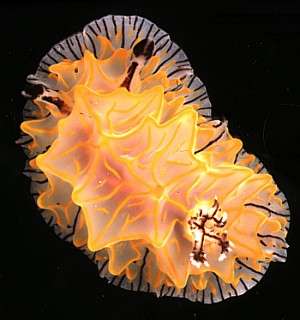
Dear Bill,
Here is a photo of Halgerda elegans found in July 1999 at the northern reef crest of Heron Island under a dead coral slab. It was 28 mm in length.
This specimen differs in some respects from both your specimens and those of Gosliner and Fahery (1998). Gosliner and Fahey state (p.254) that some of the external differences between Halgerda elegans and Halgerda albocristata (apart from the major difference that H. elegans has yellow lines on the dorsal ridges and H. albocristata has white lines) are that H. elegans has no coloured lines in the spaces between the ridges and that the black lines forming the border round the mantle skirt are wider and fewer in number than in H. albocristata.
However the Heron Island specimen shows that there are short yellow lines in the spaces between the ridges and the lines round the mantle edge are just as narrow and numerous as on H. albocristata (see other photos). These differences may be because the specimen I found was much larger (28 mm) compared to Gosliner and Fahey's specimens (5-10 mm).
Best wishes,
Julie Marshall
j.marshall@latrobe.edu.au
Marshall, J., 2000 (Mar 12) Halgerda elegans from Heron Island. [Message in] Sea Slug Forum. Australian Museum, Sydney. Available from http://www.seaslugforum.net/find/2077Thanks Julie,
As I showed before, in Bergh's illustrations of H. elegans there are black marks in the 'valleys' between the ridges. They are also present in my photos at the top of this page.
Best wishes,
Bill Rudman.
Halgerda elegans
March 8, 2000
From: Bill Rudman
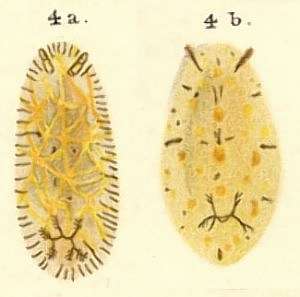
To assist in the discussion on species of Halgerda I have added a page on Halgerda elegans, with the radiating black lines on the mantle skirt.
Gosliner & Fahey (1998) consider that in H. elegans there are no black lines in the spaces between the yellow ridges, but in Bergh's original illustrations, which I reproduce here, there are some black marks between the ridges. [Bergh, 1905, Siboga Expedition Report, 50: Pl 2, fig.4, 4a - 4a labelled H. elegans var.]
Bill Rudman.
